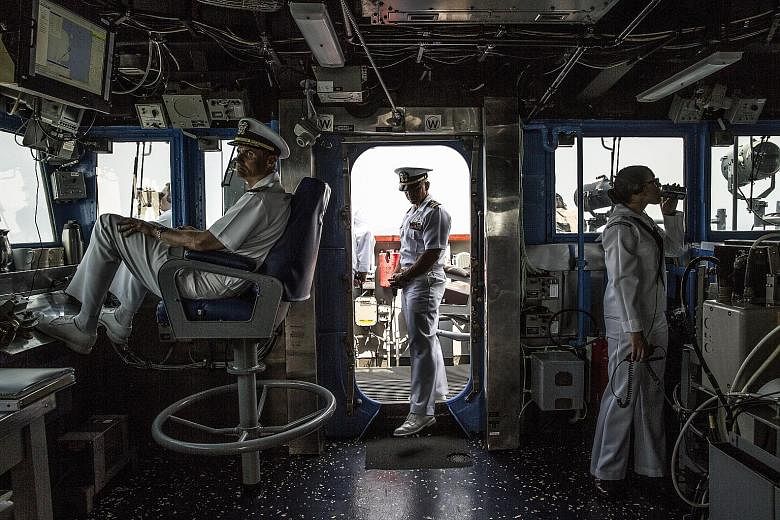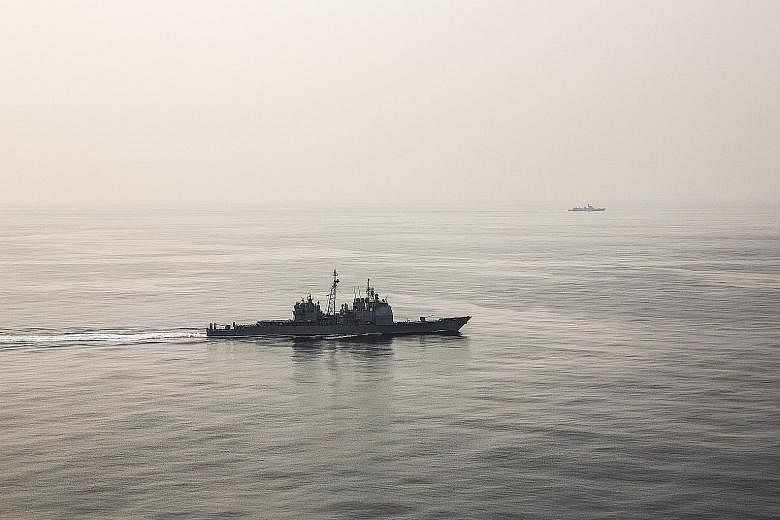ABOARD THE USS CHANCELLORSVILLE (in the South China Sea) • The US Navy cruiser was in disputed waters off the Spratly Islands when the threat warning sounded over the ship's intercom summoning all crew members to their positions as a Chinese naval frigate appeared on the horizon, bearing down on the cruiser Chancellorsville last week from the direction of Mischief Reef. More alarming, a Chinese helicopter that had taken off from the frigate was heading straight for the American cruiser.
"This is US Navy warship on guard," Ensign Anthony Giancana said into his radio from the ship's bridge, trying to contact the helicopter. "Come up on Frequency 121.5 or 243."
Ominously, there was no response. Aboard the Chancellorsville, the minutes - and the tension - stretched out as the Chinese helicopter pilot refused to answer. The helicopter kept circling and eventually flew back to the Chinese frigate, which then continued towards the American warship.
Here in the waters off the Spratly and Paracel islands - which encompass reefs, banks and cays - the United States and China are jockeying for dominance in the Pacific.
-
The exchange between warships
-
Here's a replay of a brief exchange between the US warship and the Chinese warship in the disputed waters of the South China Sea.
Chinese warship in English: "US Navy Warship 62. This is Chinese Warship 575." US warship in English: "This is US Warship 62. Good morning, sir. It is a pleasant day at sea, over."
No response. US warship in English: "This is US Warship 62. Good morning, sir. It is a pleasant day to be at sea, over."
Still no response.
US warship in Chinese: "Chinese Warship 575, this is US Warship 62. Today is a sunny day for a sea voyage, over."
Chinese warship in Chinese: "US Warship 62, this is Chinese Warship 575. Today's weather is great. It is a pleasure to meet you at sea."
US warship in Chinese: "This is US Warship 62. The weather is indeed great. It is a pleasure to meet you, too, over."
Chinese warship switches to English: "How long have you been since departing from your home port? Over."
US warship in English: "Chinese Warship 575, this is US Navy Warship 62. We do not talk about our schedules. But we are enjoying our time at sea, over."
The US warship makes a turn to see if the Chinese vessel is tailing it, and it is.
Chinese warship in English: "US Navy Warship 62, this is Chinese Navy Warship 575. Do you continue to have long-term voyage at sea? Over."
US warship in English: "This is US Navy Warship 62. Roger, all of our voyages are short because we enjoy our time at sea no matter how long we are away from home. Over."
Chinese warship in English: "US Navy Warship 62, this is Chinese Navy Warship 575. Copy that I will be staying along with you for the following days. Over."
NEW YORK TIMES
From Mischief Reef, where China is building a military base amid claims by Vietnam and the Philippines, to Scarborough Shoal, where the Chinese are building and equipping outposts on disputed territory far from the mainland, the two naval forces are on an almost continuous state of alert.
The US administration is sending Navy patrols through the Spratlys and other disputed island chains in the region, to drive home the message that the sea is free to all. Some 700 American patrols have gone through in the past year, US Navy officials say.
Three weeks ago, the aircraft carrier John C. Stennis and four other American warships sailed into the South China Sea for routine exercises, meant to convey the message, Pentagon officials said, that the US is the dominant military power in the region.
Finally, when the Chinese frigate was 10km away from the Chancellorsville and clearly visible to the naked eye on the horizon, the ship-to-ship radio crackled with the sound of accented English as the Chinese frigate made contact.
The two warships, loaded with missiles, torpedoes and heavy artillery, confronted each other with an exchange of weather pleasantries at sea.
After being tailed by the Chinese frigate on Tuesday last week, the US Navy warship was kept under surveillance the following day by a destroyer, which shadowed the Chancellorsville until midnight on Thursday last week, when the American vessel exited the South China Sea.
In Beijing yesterday, China's Defence Ministry denounced speculation that it would declare an air defence zone over the disputed area, a day after US Deputy Defence Secretary Robert Work said Washington would view such a move as "destabilising".
Mr Work said the US would not recognise such an exclusion zone in the South China Sea, just as it did not recognise the one China established over the East China Sea.
Chinese Defence Ministry spokesman Yang Yujun, asked about Mr Work's remarks, said that any sovereign state had the right to set up an air defence identification zone (ADIZ).
"On this, there is no need for other countries to gesticulate," Mr Yang told a monthly news briefing. "Whether or not to, or when to, set up an ADIZ depends on whether there is an aerial threat or the level of aerial threat. It needs many considerations," he added, without elaborating.
China, for its part, has accused the US of militarising the South China Sea through its freedom of navigation patrols in the region and the expansion of military alliances with countries such as the Philippines.
Mr Yang said the recent agreement between the US and the Philippines allowing for an American military presence at five Philippine bases represented "outdated Cold War thinking" which Washington should ditch.
NEW YORK TIMES, REUTERS


